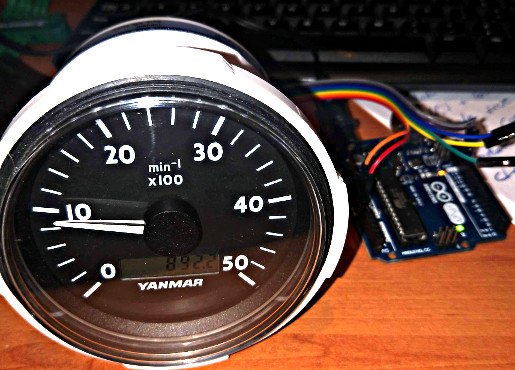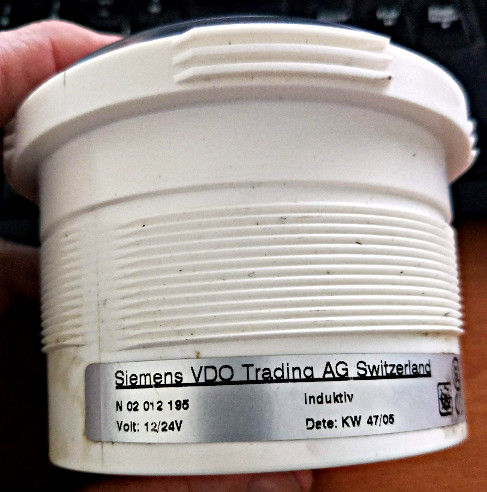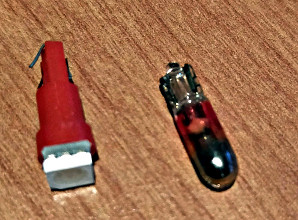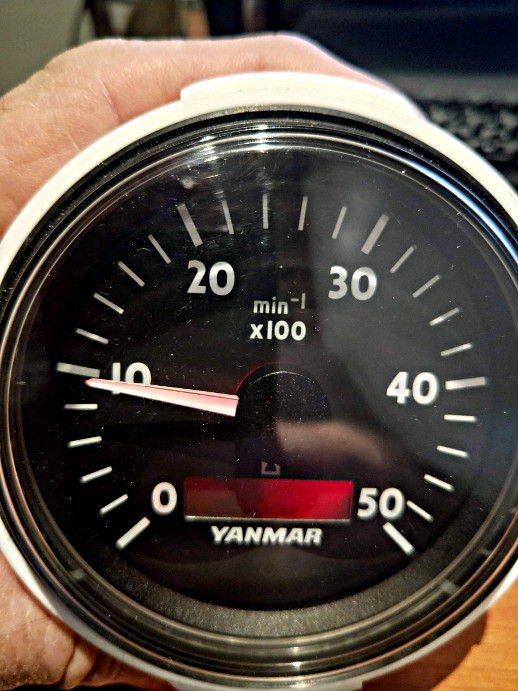
Tacho Troubles
Symptom: Turning key to on – tacho displayed as normal, hours displayed, pointer at 0 RPM. Start Engine: Hours would flash but not count up as time went by. Pointer stayed on 0 RPM.
Solution: Press the configuration button.
When I purchased Caree the tacho stopped working before I sailed for Fremantle, not wanting to push back the departure date any further, we sailed home without a tacho after some general tinkering around.
Caree is powered by a Yanmar 4JH4AE engine, with the ‘C’ type instrument panel. The signal for the tacho is obtained from the ‘W’ terminal on the second alternator.
The tacho is a VDO unit used by several manufacturers including Yanmar, and Volvo Penta. It tends to suffer from a breakdown in the solution used to corrosion proof the hour metre LCD. This is covered very well by Lucas Spaniard in his Youtube video tutorial below. First check that you have about 8 volts AC on the sense wire ( Easy way of measuring the DC square wave from the alternators ‘W’ post )
This wasn’t Caree’s problem however. I think that when the tacho died, it was actually the voltage regulator on the second alternator that had died. Unfortunately we didn’t know the regulator had gone until we were in the Western Kimberly when the house battery bank went into overcharge and started smoking. The batteries were replaced in Dampier and left to charge from the main alternator, solar panels and wind generator. The alternator was replaced in Broome. A complete non genuine unit was flown in from the other side of Australia for less than one quarter the price of a genuine part. The installation of the new alternator should of rectified the tacho problem however it wasn’t to be.
I finally had time to take a look at the tacho. It would fire up when power was applied and the hours would be displayed. On starting the engine, the hours would flash but not count up and the needle would not move. I decided to take the tacho home and do a little research and testing. To power the unit would required a 12V DC supply and a square wave supply to imitate the ‘W’ terminal source. The unit counts the number or pulses and converts that into RPM via a stepper motor.

VDO/Yanmar Model Number N02 012 195
Working out the pulses
I decided to use an Arduino UNO powered by a 12 volt plug pack to provide the 12V DC via the Vin and GND pins and pulse via a digital pin. The number of pulses required per revolution is worked out by measuring the diameter of the crank shaft pulley and alternator pulley diameter, divide the crankshaft measurement by the alternator measurement then multiply it by half the number of poles in the alternator.
- Crankshaft Pulley 127mm
- Alternator Pulley 74mm
- Alternator Poles 12
Pulses per engine revolution = 127 / 74 * 12 / 2 = 10.297 or 10.3
Building a pulse generator with power supply
I purchased an Arduino UNO for $11 delivered to my door. Then loaded it with the following code.
void setup() {
// put your setup code here, to run once:
pinMode(13, OUTPUT); // sets the pin as output
}
void loop() {
// put your main code here, to run repeatedly:
digitalWrite(13, HIGH); // sets the digital pin 13 on
delay(3); // waits for a few microseconds
digitalWrite(13, LOW); // sets the digital pin 13 off
delay(3); // waits some more
}
There was a little fiddling around to get the correct delay.

Tacho hooked up to the Arduino UNO
Testing it out
I hooked it all up and nothing had changed. I then remembered the tinkering around and read about the programming of the tacho. I pushed the configuration button and waited for a while and the tacho fired into life showing a steady 1000 RPM. Changing the figures in the program also changed the RPM – all good. So after all of the messing around it just needed the configuration button pressed after the alternator had been replaced.
Blown Bulbs
The bulbs were also blown, so for reliability I changed them to the LED version of the T5 286. This gave a nice red glow. Great for night sailing.

T5 286 – LED on the left standard on the right

Red glow from new LED globes